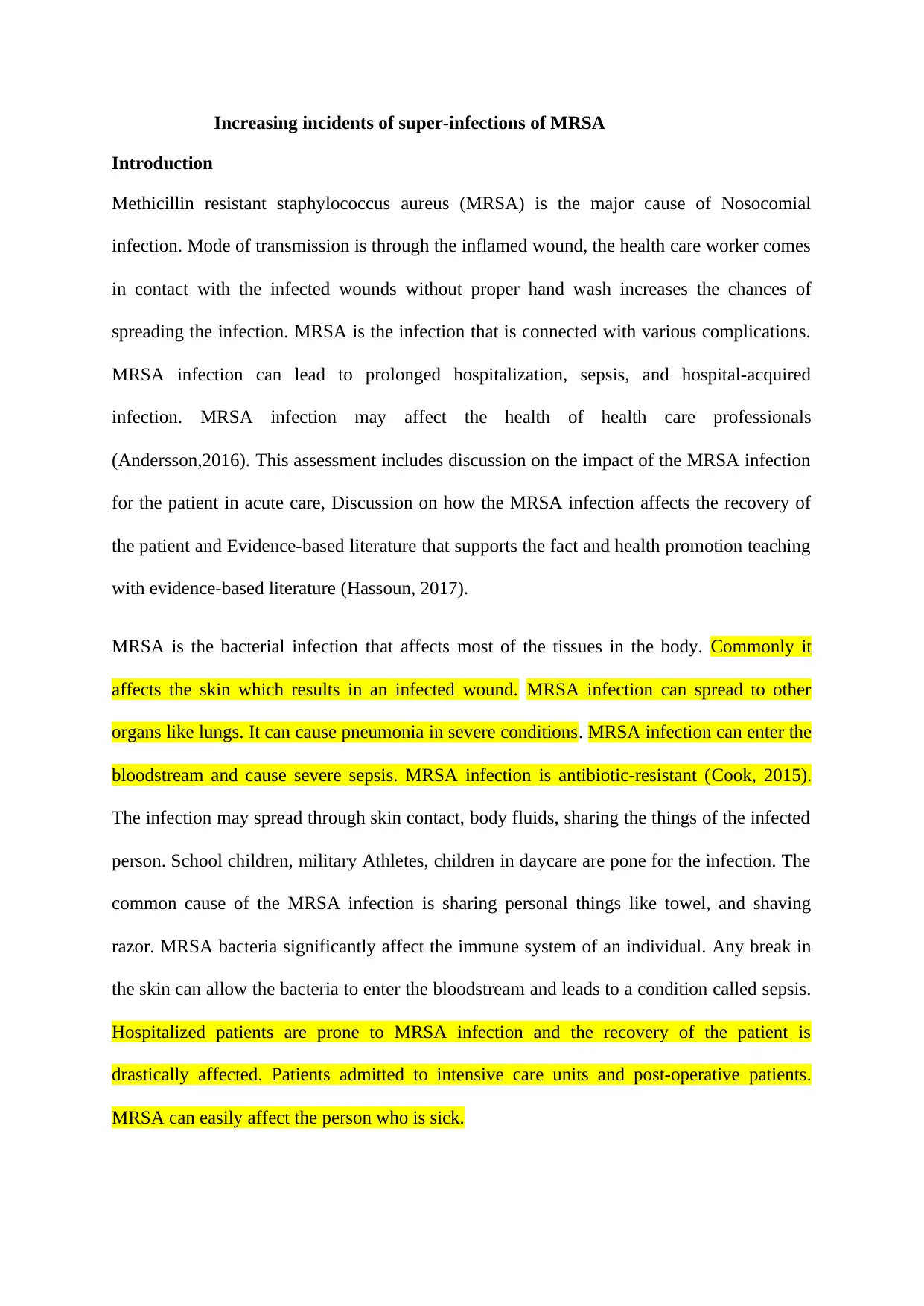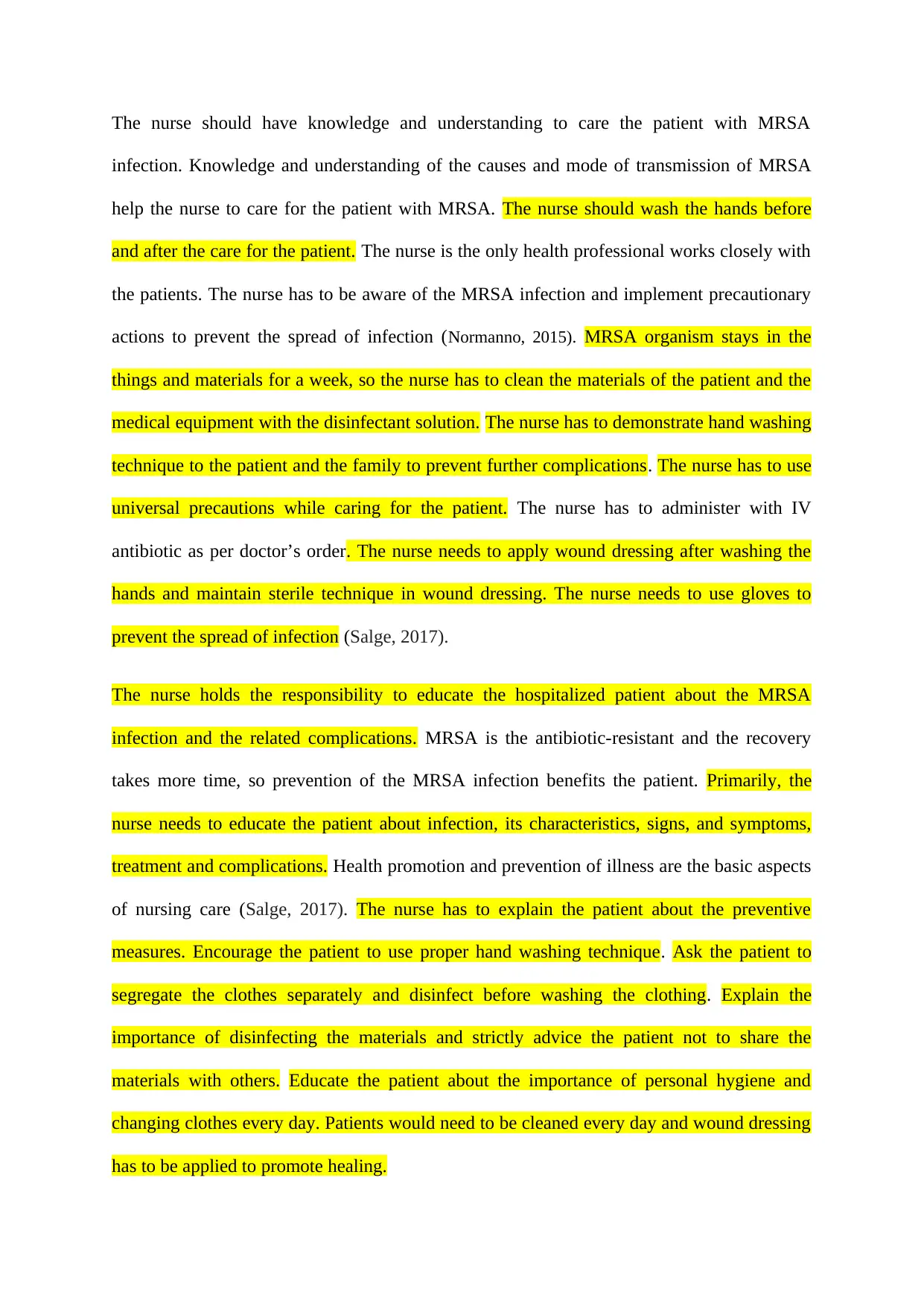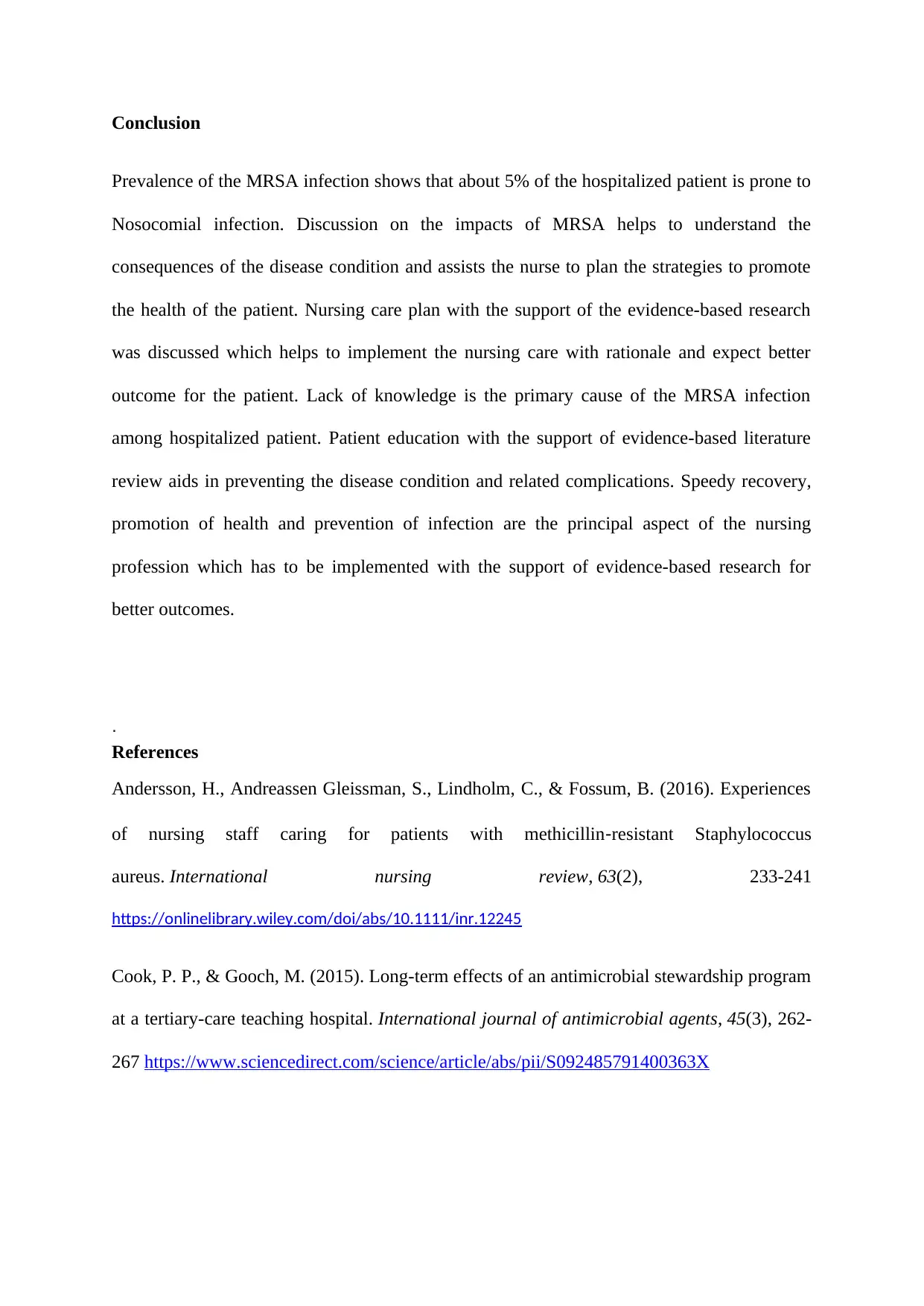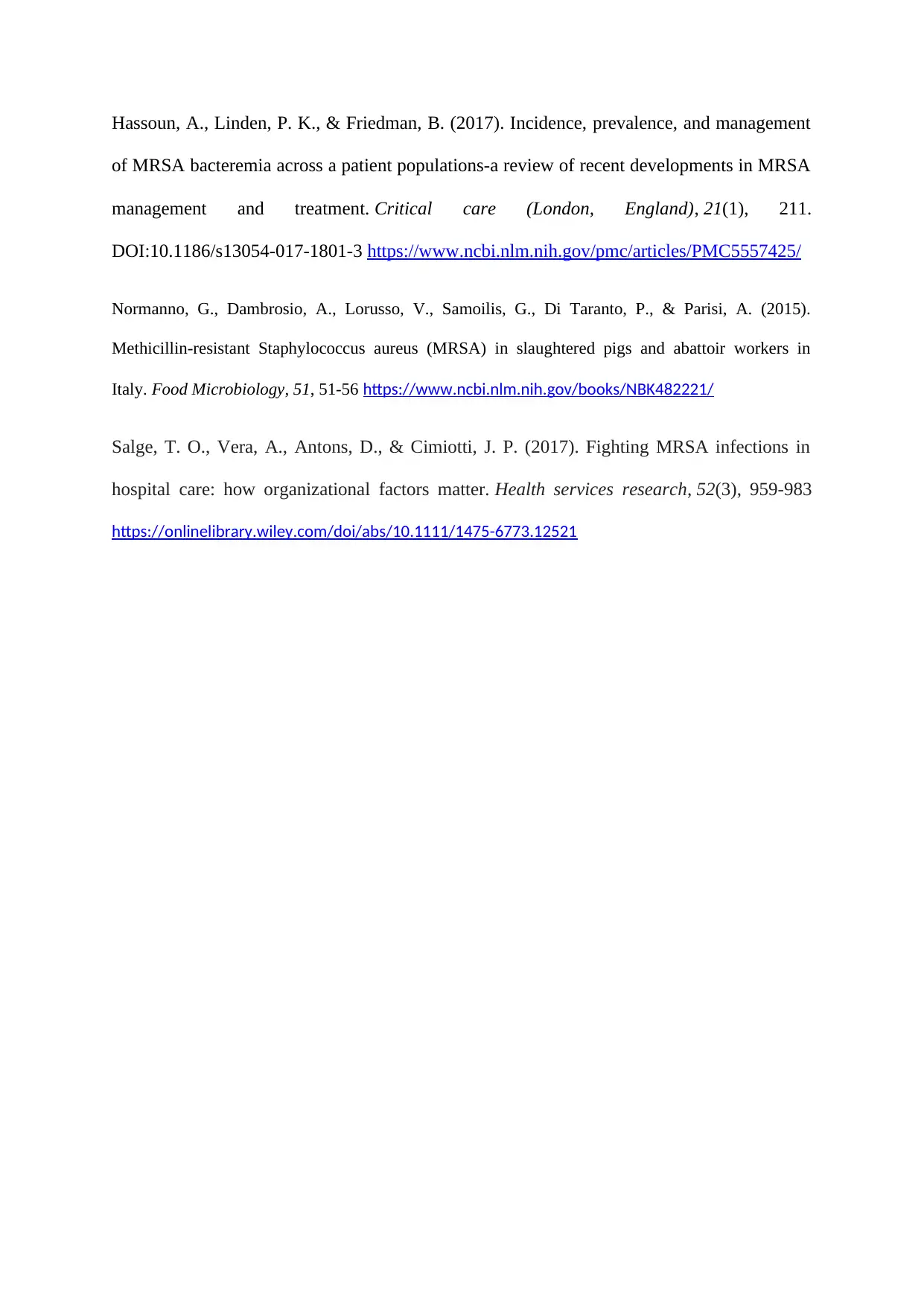MRSA Infection: Nursing Care, Patient Impact, and Prevention
VerifiedAdded on 2022/10/06
|4
|1111
|32
Report
AI Summary
This report examines methicillin-resistant Staphylococcus aureus (MRSA) infections, a major cause of nosocomial infections. It discusses the mode of transmission, complications like prolonged hospitalization and sepsis, and the impact on both patients and healthcare professionals. The report highlights the importance of nursing care, including handwashing, proper use of disinfectants, and universal precautions to prevent the spread of infection. It emphasizes the nurse's role in educating patients about MRSA, its characteristics, treatment, and preventive measures. The report provides evidence-based literature to support nursing interventions, focusing on health promotion, patient education, and the importance of hygiene to prevent MRSA and its complications. The conclusion stresses the need for evidence-based practice to improve patient outcomes and prevent the spread of infection.

Increasing incidents of super-infections of MRSA
Introduction
Methicillin resistant staphylococcus aureus (MRSA) is the major cause of Nosocomial
infection. Mode of transmission is through the inflamed wound, the health care worker comes
in contact with the infected wounds without proper hand wash increases the chances of
spreading the infection. MRSA is the infection that is connected with various complications.
MRSA infection can lead to prolonged hospitalization, sepsis, and hospital-acquired
infection. MRSA infection may affect the health of health care professionals
(Andersson,2016). This assessment includes discussion on the impact of the MRSA infection
for the patient in acute care, Discussion on how the MRSA infection affects the recovery of
the patient and Evidence-based literature that supports the fact and health promotion teaching
with evidence-based literature (Hassoun, 2017).
MRSA is the bacterial infection that affects most of the tissues in the body. Commonly it
affects the skin which results in an infected wound. MRSA infection can spread to other
organs like lungs. It can cause pneumonia in severe conditions. MRSA infection can enter the
bloodstream and cause severe sepsis. MRSA infection is antibiotic-resistant (Cook, 2015).
The infection may spread through skin contact, body fluids, sharing the things of the infected
person. School children, military Athletes, children in daycare are pone for the infection. The
common cause of the MRSA infection is sharing personal things like towel, and shaving
razor. MRSA bacteria significantly affect the immune system of an individual. Any break in
the skin can allow the bacteria to enter the bloodstream and leads to a condition called sepsis.
Hospitalized patients are prone to MRSA infection and the recovery of the patient is
drastically affected. Patients admitted to intensive care units and post-operative patients.
MRSA can easily affect the person who is sick.
Introduction
Methicillin resistant staphylococcus aureus (MRSA) is the major cause of Nosocomial
infection. Mode of transmission is through the inflamed wound, the health care worker comes
in contact with the infected wounds without proper hand wash increases the chances of
spreading the infection. MRSA is the infection that is connected with various complications.
MRSA infection can lead to prolonged hospitalization, sepsis, and hospital-acquired
infection. MRSA infection may affect the health of health care professionals
(Andersson,2016). This assessment includes discussion on the impact of the MRSA infection
for the patient in acute care, Discussion on how the MRSA infection affects the recovery of
the patient and Evidence-based literature that supports the fact and health promotion teaching
with evidence-based literature (Hassoun, 2017).
MRSA is the bacterial infection that affects most of the tissues in the body. Commonly it
affects the skin which results in an infected wound. MRSA infection can spread to other
organs like lungs. It can cause pneumonia in severe conditions. MRSA infection can enter the
bloodstream and cause severe sepsis. MRSA infection is antibiotic-resistant (Cook, 2015).
The infection may spread through skin contact, body fluids, sharing the things of the infected
person. School children, military Athletes, children in daycare are pone for the infection. The
common cause of the MRSA infection is sharing personal things like towel, and shaving
razor. MRSA bacteria significantly affect the immune system of an individual. Any break in
the skin can allow the bacteria to enter the bloodstream and leads to a condition called sepsis.
Hospitalized patients are prone to MRSA infection and the recovery of the patient is
drastically affected. Patients admitted to intensive care units and post-operative patients.
MRSA can easily affect the person who is sick.
Paraphrase This Document
Need a fresh take? Get an instant paraphrase of this document with our AI Paraphraser

The nurse should have knowledge and understanding to care the patient with MRSA
infection. Knowledge and understanding of the causes and mode of transmission of MRSA
help the nurse to care for the patient with MRSA. The nurse should wash the hands before
and after the care for the patient. The nurse is the only health professional works closely with
the patients. The nurse has to be aware of the MRSA infection and implement precautionary
actions to prevent the spread of infection (Normanno, 2015). MRSA organism stays in the
things and materials for a week, so the nurse has to clean the materials of the patient and the
medical equipment with the disinfectant solution. The nurse has to demonstrate hand washing
technique to the patient and the family to prevent further complications. The nurse has to use
universal precautions while caring for the patient. The nurse has to administer with IV
antibiotic as per doctor’s order. The nurse needs to apply wound dressing after washing the
hands and maintain sterile technique in wound dressing. The nurse needs to use gloves to
prevent the spread of infection (Salge, 2017).
The nurse holds the responsibility to educate the hospitalized patient about the MRSA
infection and the related complications. MRSA is the antibiotic-resistant and the recovery
takes more time, so prevention of the MRSA infection benefits the patient. Primarily, the
nurse needs to educate the patient about infection, its characteristics, signs, and symptoms,
treatment and complications. Health promotion and prevention of illness are the basic aspects
of nursing care (Salge, 2017). The nurse has to explain the patient about the preventive
measures. Encourage the patient to use proper hand washing technique. Ask the patient to
segregate the clothes separately and disinfect before washing the clothing. Explain the
importance of disinfecting the materials and strictly advice the patient not to share the
materials with others. Educate the patient about the importance of personal hygiene and
changing clothes every day. Patients would need to be cleaned every day and wound dressing
has to be applied to promote healing.
infection. Knowledge and understanding of the causes and mode of transmission of MRSA
help the nurse to care for the patient with MRSA. The nurse should wash the hands before
and after the care for the patient. The nurse is the only health professional works closely with
the patients. The nurse has to be aware of the MRSA infection and implement precautionary
actions to prevent the spread of infection (Normanno, 2015). MRSA organism stays in the
things and materials for a week, so the nurse has to clean the materials of the patient and the
medical equipment with the disinfectant solution. The nurse has to demonstrate hand washing
technique to the patient and the family to prevent further complications. The nurse has to use
universal precautions while caring for the patient. The nurse has to administer with IV
antibiotic as per doctor’s order. The nurse needs to apply wound dressing after washing the
hands and maintain sterile technique in wound dressing. The nurse needs to use gloves to
prevent the spread of infection (Salge, 2017).
The nurse holds the responsibility to educate the hospitalized patient about the MRSA
infection and the related complications. MRSA is the antibiotic-resistant and the recovery
takes more time, so prevention of the MRSA infection benefits the patient. Primarily, the
nurse needs to educate the patient about infection, its characteristics, signs, and symptoms,
treatment and complications. Health promotion and prevention of illness are the basic aspects
of nursing care (Salge, 2017). The nurse has to explain the patient about the preventive
measures. Encourage the patient to use proper hand washing technique. Ask the patient to
segregate the clothes separately and disinfect before washing the clothing. Explain the
importance of disinfecting the materials and strictly advice the patient not to share the
materials with others. Educate the patient about the importance of personal hygiene and
changing clothes every day. Patients would need to be cleaned every day and wound dressing
has to be applied to promote healing.

Conclusion
Prevalence of the MRSA infection shows that about 5% of the hospitalized patient is prone to
Nosocomial infection. Discussion on the impacts of MRSA helps to understand the
consequences of the disease condition and assists the nurse to plan the strategies to promote
the health of the patient. Nursing care plan with the support of the evidence-based research
was discussed which helps to implement the nursing care with rationale and expect better
outcome for the patient. Lack of knowledge is the primary cause of the MRSA infection
among hospitalized patient. Patient education with the support of evidence-based literature
review aids in preventing the disease condition and related complications. Speedy recovery,
promotion of health and prevention of infection are the principal aspect of the nursing
profession which has to be implemented with the support of evidence-based research for
better outcomes.
.
References
Andersson, H., Andreassen Gleissman, S., Lindholm, C., & Fossum, B. (2016). Experiences
of nursing staff caring for patients with methicillin‐resistant Staphylococcus
aureus. International nursing review, 63(2), 233-241
https://onlinelibrary.wiley.com/doi/abs/10.1111/inr.12245
Cook, P. P., & Gooch, M. (2015). Long-term effects of an antimicrobial stewardship program
at a tertiary-care teaching hospital. International journal of antimicrobial agents, 45(3), 262-
267 https://www.sciencedirect.com/science/article/abs/pii/S092485791400363X
Prevalence of the MRSA infection shows that about 5% of the hospitalized patient is prone to
Nosocomial infection. Discussion on the impacts of MRSA helps to understand the
consequences of the disease condition and assists the nurse to plan the strategies to promote
the health of the patient. Nursing care plan with the support of the evidence-based research
was discussed which helps to implement the nursing care with rationale and expect better
outcome for the patient. Lack of knowledge is the primary cause of the MRSA infection
among hospitalized patient. Patient education with the support of evidence-based literature
review aids in preventing the disease condition and related complications. Speedy recovery,
promotion of health and prevention of infection are the principal aspect of the nursing
profession which has to be implemented with the support of evidence-based research for
better outcomes.
.
References
Andersson, H., Andreassen Gleissman, S., Lindholm, C., & Fossum, B. (2016). Experiences
of nursing staff caring for patients with methicillin‐resistant Staphylococcus
aureus. International nursing review, 63(2), 233-241
https://onlinelibrary.wiley.com/doi/abs/10.1111/inr.12245
Cook, P. P., & Gooch, M. (2015). Long-term effects of an antimicrobial stewardship program
at a tertiary-care teaching hospital. International journal of antimicrobial agents, 45(3), 262-
267 https://www.sciencedirect.com/science/article/abs/pii/S092485791400363X
⊘ This is a preview!⊘
Do you want full access?
Subscribe today to unlock all pages.

Trusted by 1+ million students worldwide

Hassoun, A., Linden, P. K., & Friedman, B. (2017). Incidence, prevalence, and management
of MRSA bacteremia across a patient populations-a review of recent developments in MRSA
management and treatment. Critical care (London, England), 21(1), 211.
DOI:10.1186/s13054-017-1801-3 https://www.ncbi.nlm.nih.gov/pmc/articles/PMC5557425/
Normanno, G., Dambrosio, A., Lorusso, V., Samoilis, G., Di Taranto, P., & Parisi, A. (2015).
Methicillin-resistant Staphylococcus aureus (MRSA) in slaughtered pigs and abattoir workers in
Italy. Food Microbiology, 51, 51-56 https://www.ncbi.nlm.nih.gov/books/NBK482221/
Salge, T. O., Vera, A., Antons, D., & Cimiotti, J. P. (2017). Fighting MRSA infections in
hospital care: how organizational factors matter. Health services research, 52(3), 959-983
https://onlinelibrary.wiley.com/doi/abs/10.1111/1475-6773.12521
of MRSA bacteremia across a patient populations-a review of recent developments in MRSA
management and treatment. Critical care (London, England), 21(1), 211.
DOI:10.1186/s13054-017-1801-3 https://www.ncbi.nlm.nih.gov/pmc/articles/PMC5557425/
Normanno, G., Dambrosio, A., Lorusso, V., Samoilis, G., Di Taranto, P., & Parisi, A. (2015).
Methicillin-resistant Staphylococcus aureus (MRSA) in slaughtered pigs and abattoir workers in
Italy. Food Microbiology, 51, 51-56 https://www.ncbi.nlm.nih.gov/books/NBK482221/
Salge, T. O., Vera, A., Antons, D., & Cimiotti, J. P. (2017). Fighting MRSA infections in
hospital care: how organizational factors matter. Health services research, 52(3), 959-983
https://onlinelibrary.wiley.com/doi/abs/10.1111/1475-6773.12521
1 out of 4
Related Documents
Your All-in-One AI-Powered Toolkit for Academic Success.
+13062052269
info@desklib.com
Available 24*7 on WhatsApp / Email
![[object Object]](/_next/static/media/star-bottom.7253800d.svg)
Unlock your academic potential
Copyright © 2020–2025 A2Z Services. All Rights Reserved. Developed and managed by ZUCOL.





